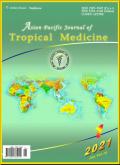登革热患者凝血异常及其与出血表现的关系——单中心观察性研究
IF 1.6
4区 医学
Q3 PUBLIC, ENVIRONMENTAL & OCCUPATIONAL HEALTH
引用次数: 1
摘要
目的:探讨登革热患者凝血功能异常及其与出血表现的关系。方法:本观察性研究对2021年7月至2022年6月在印度西部一家三级医院住院的292名成年登革热患者进行了研究。凝血试验包括凝血酶原时间(PT)、国际标准化比值(INR)、活化部分凝血活酶时间(aPTT)、纤维蛋白原和d -二聚体。监测患者的出血表现。结果:42.8%的患者出现凝血功能异常。总的来说,aPTT延长是最常见的凝血异常(40.8%),其次是纤维蛋白原低(38.7%)、d -二聚体升高(31.2%)、INR升高(26.0%)和PT延长(19.2%)。19.9%的患者有出血表现。出血组PT、INR、aPTT、d -二聚体水平显著高于无出血组(P<0.01),纤维蛋白原水平显著低于无出血组(P<0.001)。出血组各项凝血异常发生率明显高于无出血组(P<0.01)。结论:出血患者的凝血异常频率明显高于无出血患者。登革热患者应评估凝血功能异常。本文章由计算机程序翻译,如有差异,请以英文原文为准。
Coagulation abnormalities and their relationship with bleeding manifestations in patients with dengue-A single center observational study
Objective: To evaluate coagulation abnormalities and their relationship with bleeding manifestations among patients with dengue. Methods: This observational study was conducted on 292 adult dengue patients who were admitted to a tertiary care hospital of Western India from July 2021 to June 2022. Coagulation tests including prothrombin time (PT), international normalized ratio (INR), activated partial thromboplastin time (aPTT), fibrinogen, and D-dimer were performed. Patients were monitored for bleeding manifestations. Results: Coagulation abnormalities were reported in 42.8% of the patients. Overall, prolonged aPTT was the most common coagulation abnormality (40.8%), followed by low fibrinogen (38.7%), raised D-dimer (31.2%), raised INR (26.0%) and prolonged PT (19.2%). Bleeding manifestations were present in 19.9% patients. PT, INR, aPTT and D-dimer levels were significantly higher (P<0.01) and fibrinogen level was significantly lower (P<0.001) in patients with bleeding compared to patients without bleeding. Patients with bleeding had a significantly higher rate of all coagulation abnormalities than patients without bleeding (P<0.01). Conclusions: Patients with bleeding showed a significantly higher frequency of coagulation abnormalities compared to patients without bleeding. Patients with dengue should be assessed for coagulation abnormalities.
求助全文
通过发布文献求助,成功后即可免费获取论文全文。
去求助
来源期刊

Asian Pacific journal of tropical medicine
PUBLIC, ENVIRONMENTAL & OCCUPATIONAL HEALTH-TROPICAL MEDICINE
CiteScore
4.00
自引率
9.70%
发文量
1936
审稿时长
3-8 weeks
期刊介绍:
Asian Pacific Journal of Tropical Medicine (ISSN 1995-7645 CODEN: APJTB6), a publication of Editorial office of Hainan Medical University,is a peer-reviewed print + online Monthly journal. The journal''s full text is available online at http://www.apjtm.org/. The journal allows free access (Open Access) to its contents and permits authors to self-archive final accepted version of the articles on any OAI-compliant institutional / subject-based repository.
APJTM aims to provide an academic communicating platform for international physicians, medical scientists, allied health scientists and public health workers, especially those of the Asia-Pacific region and worldwide on tropical medicine, infectious diseases and public health, and to meet the growing challenges of understanding, preventing and controlling the dramatic global emergence and re-emergence of infectious diseases in the Asia-Pacific.
The journal is proud to have an international and diverse editorial board that will assist and facilitate the publication of articles that reflect a global view on tropical medicine, infectious diseases and public health, as well as emphasizing our focus on supporting the needs of public health practitioners. The APJTM will allow us to seek opportunities to work with others who share our aim, and to enhance our work through partnership, and to uphold the standards of our profession and contribute to its advancement.
 求助内容:
求助内容: 应助结果提醒方式:
应助结果提醒方式:


